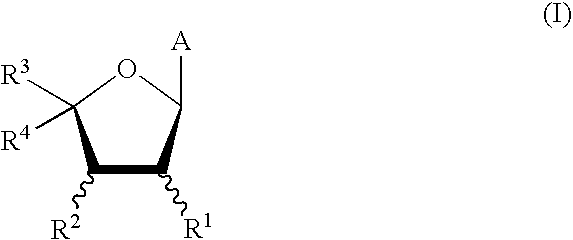Mutant purine nucleoside phosphorylase proteins and cellular delivery thereof
a technology of phosphorylase and purine nucleoside, applied in the direction of transferases, nanomedicine, application, etc., can solve the problems of limited tumor treatment effect using prodrug activation techniques, undesirable immunosuppressive effects, and undesirable side effects
- Summary
- Abstract
- Description
- Claims
- Application Information
AI Technical Summary
Benefits of technology
Problems solved by technology
Method used
Image
Examples
example 1
[0061] Preparation of 2-Fluoro-9-(2,3,5-tri-O-benzoyl-α-L-lyxofuranosyl)-9H-purin-6-amine (1a) A suspension of a 2-fluoroadenine (107.8 mg, 0.70 mmol) and ammonium sulfate (5.3 mg) in 1,1,1,3,3,3-hexamethyldisilazane (HMDS) (10 ml) is refluxed under argon for 7 h. More ammonium sulfate (4.6 mg) is added, and reflux is continued for 24 h. After cooling the reaction mixture to room temperature, the HMDS is removed in vacuo, and the residue is co-evaporated with anhydrous toluene (3×3 ml). To this material is added 1-O-acetyl-2,3,5-tri-O-benzoyl-L-lyxofuranose (212 mg, 0.42 mmol) dissolved in anhydrous acetonitrile (7 ml). The resulting suspension is chilled to −10° C. before being treated dropwise over 5 min with 2.1 ml of 1.0 M stannic chloride (SnCl4) in dichloromethane. The now clear reaction solution is warmed to 0° C. over 15 min and then stirred at room temperature. After 3 h, the solution is added dropwise to ice-cold saturated NaHCO3 (100 ml) and stirred 10 min at 5° C. Ethyl ...
example 2
Preparation of 2-Fluoro-9-(α-L-lyxofuranosyl)-9H-purin-6-amine (1b)
[0062] A suspension of 1a (108 mg, 0.18 mmol) in ethanol (10 ml) at room temperature is treated in one portion with 0.50 M KOH (anhydrous powder) in ethanol (180 μl). The mixture is stirred 5 h, neutralized with glacial acetic acid (6 μl), and evaporated to dryness. The resulting residue is crystallized from 1:1 acetonitrile / water to afford pure (1b) as a white solid.
example 3
Preparation of 9-(2.3,5-Tri-O-benzoyl-α-L-lyxofuranosyl)-6-methylpurine (1c)
[0063] To a suspension of 6-methylpurine (230 mg, 1.71 mmol) in anhydrous dichloroethane (6 ml) under argon is added HMDS (2.5 ml, 11.8 mmol) followed by chlorotrimethylsilane (215 μl, 1.69 mmol). After a 2 h reflux, the resulting clear solution is evaporated in vacuo, and the residue is co-evaporated with anhydrous toluene (4×2 ml). A solution of tri-O-benzoyl-L-lyxofuranose (427 mg, 0.85 mmol) in acetonitrile (10 ml) is added to the above silylated purine. This mixture is chilled to −10° C. before the dropwise addition of 1.0 M SnCl4 in dichloromethane (4.25 ml) over 10 min. After an additional 10 min at −10° C., the reaction mixture is stirred at room temperature 4.5 h. Workup of the reaction solution is carried out as described for the preparation of 1a to give a pink foam.
[0064] Column chromatography on silica gel (10 g) with 1:1 hexane / ethyl acetate as solvent provided 1c as a white foam.
PUM
| Property | Measurement | Unit |
|---|---|---|
| volume | aaaaa | aaaaa |
| volume | aaaaa | aaaaa |
| pH | aaaaa | aaaaa |
Abstract
Description
Claims
Application Information
 Login to View More
Login to View More - R&D
- Intellectual Property
- Life Sciences
- Materials
- Tech Scout
- Unparalleled Data Quality
- Higher Quality Content
- 60% Fewer Hallucinations
Browse by: Latest US Patents, China's latest patents, Technical Efficacy Thesaurus, Application Domain, Technology Topic, Popular Technical Reports.
© 2025 PatSnap. All rights reserved.Legal|Privacy policy|Modern Slavery Act Transparency Statement|Sitemap|About US| Contact US: help@patsnap.com



